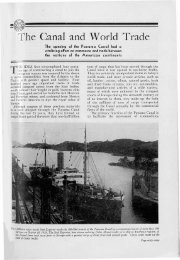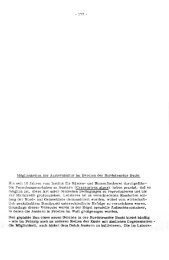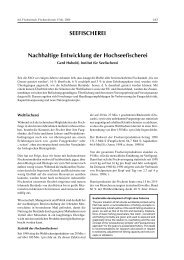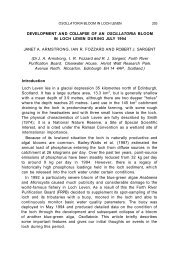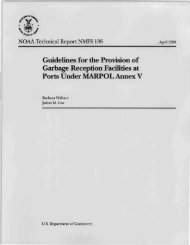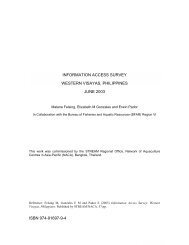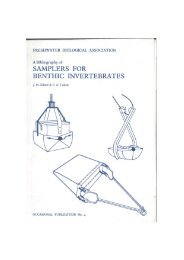The Economic Importance Of Marine Angler Expenditures In
The Economic Importance Of Marine Angler Expenditures In
The Economic Importance Of Marine Angler Expenditures In
Create successful ePaper yourself
Turn your PDF publications into a flip-book with our unique Google optimized e-Paper software.
For the same reason, summation of impact estimates<br />
across states would result in an underestimate of the total<br />
economic effects attributable to angler expenditures<br />
in each region. Consideration was given to constructing<br />
aggregate input-output models by region, but it was<br />
determined that the statistical procedures required<br />
to estimate participation for these new regions would<br />
have jeopardized the authenticity of the results. Given<br />
the nature of the MRFSS participation data it would<br />
be impossible to accurately estimate the proportion of<br />
out-of-region or non-resident participation. Thus, no attempt<br />
was made to use aggregate models to calculate the<br />
total regional impacts of angler expenditures, except at<br />
the national level where the MRFSS data can be used to<br />
estimate national participation, ignoring the small proportion<br />
of non-U.S. resident participants. Readers interested<br />
in determining region-wide values are cautioned<br />
that the summation of the state-level impact estimates<br />
would likely underestimate the total regional economic<br />
effects attributable to angler expenditures.<br />
It is difficult to compare the impacts generated from<br />
marine recreational fishing to those generated from<br />
commercial fishing and no attempt was made to do so<br />
here. Recreational impacts are often compared to the<br />
dockside value of commercial fisheries landings, but this<br />
comparison fails to recognize the value-added impacts associated<br />
with fish processors, wholesale fish dealers, and<br />
the retail markets where the commercial catch is sold<br />
to consumers. <strong>The</strong>se forward linked sectors could add<br />
considerable sales, income, and employment impacts<br />
to those generated from commercial harvesting alone.<br />
Studies that attempt to compare the impacts generated<br />
from recreational fishing to those generated from the<br />
sale of seafood in commercial markets should attempt<br />
to incorporate all of the backward and forward linkages<br />
associated with the commercial harvesting of seafood. 16<br />
Although input-output modeling is the most common<br />
approach for describing the structure and interactions<br />
of regional economies, it is prudent to be aware of its<br />
assumptions regarding linear production functions,<br />
constant relative prices, and homogenous sector output.<br />
<strong>The</strong>se assumptions are of questionable validity, but are<br />
necessary in order to construct the technical coefficients<br />
used to determine the direct, indirect, and induced<br />
effects in an input-output model. <strong>In</strong> fact, Propst and<br />
Gavrilis (1987) considered these assumptions in their<br />
assessment of regional economic impact procedures<br />
16 Recreational fishing may also generate additional sales, income,<br />
employment, and tax impacts through incidental purchases by<br />
nonfishing companions and the auxiliary expenditures that occur<br />
on trips that were part of a longer vacation. If these types of expenditures<br />
occur as a direct result of fishing, a case could be made that<br />
any comparison to the commercial sector should also include the<br />
impacts generated from these supplemental expenditures.<br />
10<br />
and concluded that the input-output approach can<br />
satisfy the widest range of information needs at high<br />
precision levels if primary data are supplied for final<br />
demand estimates (i.e., collected directly from anglers<br />
as was done for this study).<br />
Another caveat that deserves attention relates to the<br />
underlying purpose and use of input-output analysis. <strong>In</strong><br />
particular, it is a positivistic model designed to identify<br />
patterns of transactions and the resource requirements<br />
and sector output requirements resulting from changes<br />
in economic activity. <strong>The</strong> input-output approach should<br />
not be considered a substitute for normative approaches<br />
such as benefit-cost analysis. Benefit-cost analysis seeks<br />
to determine whether resources are being put to their<br />
best use by examining the difference between total<br />
economic value and total costs. <strong>In</strong> the context of recreational<br />
fishing, total net economic value is generally<br />
defined as willingness to pay in excess of actual expenditures.<br />
Alternatively, input-output assessments reveal how<br />
actual expenditures affect economic activity within each<br />
sector of an economy.<br />
Finally, the effect of proposed management measures<br />
on the sales, income, employment, and taxes generated<br />
from angler expenditures depends upon the behavioral<br />
sensitivity of the affected anglers to regulations. If management<br />
restrictions result in a decrease in the overall<br />
number of recreational fishing trips, thereby lowering<br />
anglers’ total expenditures, there will be a reduction in<br />
the sales, service, and manufacturing sectors associated<br />
with recreational fishing expenses. <strong>In</strong> conjunction with<br />
appropriate demand models, these reductions could<br />
be estimated from the input-output models developed<br />
in this study. <strong>The</strong>se demand models have only been<br />
empirically estimated for a small number of fisheries<br />
as the data collection efforts needed to estimate these<br />
models are time consuming and expensive. Some examples<br />
of this type of work include Hamel et al. (2002)<br />
covering Pacific halibut and salmon in the Lower and<br />
Central Cook <strong>In</strong>let, Alaska, and a 2000 effort by NMFS<br />
covering summer flounder in the Mid-Atlantic and New<br />
England regions (Gentner, personal commun., 2003).<br />
To increase the species and regions covered, NMFS<br />
currently has several stated preference surveys underway<br />
covering several key species in the South Atlantic,<br />
Gulf, and Pacific coasts. Regardless of the policy models<br />
available, there are many businesses that are directly or<br />
indirectly dependent upon recreational fishing expenditures<br />
and an attempt should be made to identify these<br />
needs when evaluating management alternatives that<br />
have the potential to alter recreational fishing effort.<br />
<strong>In</strong> the absence of appropriate demand models, sensitivity<br />
evaluations could be conducted with the models<br />
developed in this study to examine the potential effects<br />
of management actions on regional sales, income, employment,<br />
and taxes.



